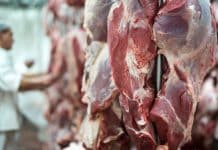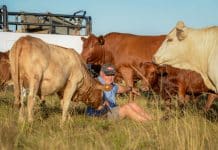The increasing demands placed on ewes in terms of multiple births in intensive, accelerated lambing systems, has triggered a marked increase in these animals’ nutritional needs. But whether the system is intensive or extensive, the producer stands to gain by becoming familiar with the nutritional needs of the ewe at the various physiological stages, says Hannes Beukes, dairy cattle and sheep nutrition specialist at Nova Feeds in Malmesbury.
“At every physiological stage there are a few physiological drivers behind the nutritional needs of the ewe. In a precision farming system, these needs must be adequately met so that the ewe can produce optimally,” Hannes explains.
According to Hannes, the physiological cycle includes the following stages: Flush feeding, early gestation, mid-gestation, late gestation, peak lactation, mid-lactation, late lactation, a dry period, and then back to flush feeding.
The primary concern of the sheep farmer is to manage the body condition of his animals. Body condition gives the farmer a baseline from which to adjust feed and nutrient requirements.
Phase: Flush feeding
Immediately prior to breeding, about 17 days before bringing in the rams, ewes should be flush fed. The objective with flush feeding is to increase the ovulation rate of the ewes. In an intensive system one would mainly flush feed young ewes. The red flag here is to not overfeed.

The aim during flush feeding is growth of approximately 100g per day. The target for young ewes is to reach 80% of their adult bodyweight at ten months. Flush feeding gives ewes a fair chance of adapting to an intensive system.
Phase: Early gestation
This period describes the first 30 days of pregnancy. The first 15 days after fertilisation fall into the pre-implantation period. Implantation then covers the next 15 days.
“During this period, it is essential not to make sudden or dramatic changes to the diet of the animal. It makes sense then to maintain the ewes in the flush feeding regime until the end of early gestation,” Hannes says.
He emphasises, however, that body condition of the ewes must be closely monitored to avoid the animals from becoming overfat.
Phase: Mid-gestation
The next 60 days, from day 30 to day 90, is mid-gestation. Historically, this phase has been seen as an ‘economical phase’, but in an intensive system it is important that ewes maintain condition during mid-gestation. This is because of the limited time available to them for building condition.
“During this phase it is important not to confuse condition with weight. Placental growth is taking place, which means the ewe is getting heavier. This has nothing to do with her condition. Loss of condition during this phase can lead to problems such as stunted lambs.”
The focus should be on condition maintenance rather than on weight. Ewes that are either emaciated or too fat during mid-gestation, will be negatively affected. Placental development may be limited by low body weight and this will lead to low birth weight, poor viability and increased lamb mortality. Overweight ewes are likely to experience difficult births.
Phase: Late gestation
This phase lasts from day 90 to day 150, an eight-week period during which 85% of foetal growth occurs. Because of the rapid growth of the foetus, the ewe’s capacity to ingest feed is reduced and it becomes crucial to provide her with a more energy-dense ration. Body condition, rather than weight, remains the top priority. Although the weight of the ewes can increase rapidly, especially with the development of twins, they could actually be losing condition.
The producer’s aim during this phase is to ensure robust lambs, and ewes that can take good care of them. Metabolic disorders should be prevented.
“If you provide too little feed during this period, it has an effect on the secondary wool follicles of lambs. This could mean that your future wool production potential may be compromised,” says Hannes.
Phase: Lactation
Transition from late gestation to early lactation is probably the stage responsible for the most headaches, says Hannes. “Ewes are extremely sensitive to change and if a ewe does not feed for even one day, it may lead to her death. This is also the period when pregnancy disease and ketosis can cause problems in the flock.

“In addition, balancing the ration during late gestation and early lactation is crucial. When the ewes are sent to the lambing pens, they are already on the lactation ration. Because lambing is a high stress period, you don’t want to increase that stress by changing to a new ration.”
Intakes should not be restricted when ewes go into the lambing pens and feed should be available on a 24-hour basis so that they can eat as much as they need.
Phase: Peak lactation
This period lasts for about 30 days after lambing. “Although it is expensive, it is worthwhile to feed ewes, especially those with multiplets, the lactation ration ad lib during peak lactation. A feeding regime like this will ensure good milk production, which has a positive effect on the growth of the lambs. At this time the feed conversion capacity of the lambs is one to one. The more milk a ewe produces, the better her lambs will grow.
“As soon as the ewes and their lambs are taken out of the lambing pens, lamb creep feed must be available. The main purpose of the creep feed ration is to develop the lamb’s rumen. Note that there is a big difference between the lactation ration and creep feed. It is important to keep the ewes out of the creep feed, but it is equally important that lambs consume more than only the lactation ration when they are with their mothers,” Hannes says.
Phase: Mid- to late lactation
The nutritional needs of the ewes become less intense during mid- to late lactation. Lamb creep feed intake is already high, which means the ewes can be put onto a cheaper ration or receive less of the lactation ration with more roughage. The ratio between roughage and concentrate must be adjusted gradually so that by the time the lambs are weaned, the ewes are eating virtually no concentrates.
Phase: The dry period
An intensive, accelerated lambing system does not really have a dry phase, as ewes are immediately prepared for their next lambing cycle. The aim in an intensive system is for the ewes to maintain their condition, so that by the time they are ready for flush feed, their body condition is on par.
“The primary goal during this phase is to maintain condition. In an intensive system, the target is a body condition score of 3,5 when the ewe is synchronised for her next pregnancy. In an extensive system, there is more time for the ewe to pick up condition. For flush feeding to be effective, the animals should have a condition score of between 2,75 and 3,” says Hannes. – Izak Hofmeyr, Stockfarm
For more information, phone Hannes Beukes on 072 404 1992.








